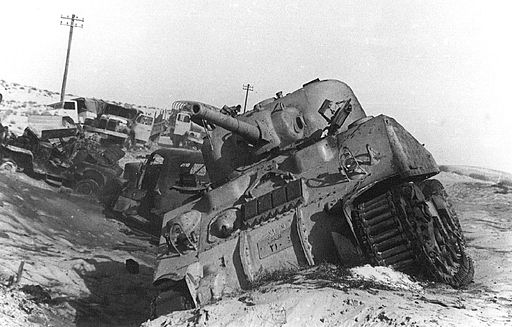International intrigues. Hidden financial interests. Secret agreements between states. Inherent distrust. And two European superpowers.
This isn’t the new Tom Clancy Novel. This is the story of the Suez Crisis, also known as the Suez Canal Crisis, the Sinai War and “Operation Kadesh”.
- Introduction to the Suez Crisis
- The Suez Crisis Emerges
- Introducing International Intrigues
- The Suez Crisis War Begins
- Aftermath and Summary of the Suez Crisis
Introduction to the Suez Crisis
It is 1956. Elvis Presley releases his first hit, “Heartbreak Hotel”. The first hard disk is invented by IBM. In Monaco, Grace Kelly marries Prince Rainier.
And in the Middle East, another turmoil begins.
It all starts with Gamal Abdel Nasser.
Who?
Gamal Abdel Nasser, the second President of Egypt.

Is it important for me to know him?
Actually, it is very important for you to know him. Nasser is pretty much the reason for three of the Israeli-Arab wars.
Wow. Okay, tell me about this Nasser guy, please!
Here you go: Nasser is an Egyptian and Arab nationalist, who believes in Arab glory. In 1948 he took part in Israel’s War of Independence – he was on the side attacking Israel, as you may have guessed. During the War of Independence, Nasser and his men were besieged by Israeli forces for 4 months, but did not break. So when he finally returned to Egypt, he was received as a hero.
Nasser became a respected military officer, climbing through the ranks, and then turned to politics. He led the 1952 overthrow of the monarchy and introduced far-reaching land reforms the following year. After an attempt on his life by a Muslim Brotherhood member, he cracked down on the organization, put President Mohamed Naguib under house arrest and assumed executive office in 1954. He was formally elected president in June 1956.
That’s pretty impressive stuff. But what does Nasser want to achieve? Why did he take the presidency?
Well, Nasser’s ideology translates to several goals:
Being an Egyptian nationalist, Nasser wants to pass many reforms and improve life in Egypt.
He is also an Arab nationalist, so he wants to unite all the Arab countries of the Middle East (thus creating pan-Arab unity), and he wants Egypt to lead this Arab world.
Nasser is a believer in Arab glory and as an Arab leader it is important to him to gain respect and radiate strength. This also means that Nasser is a supporter of the anti-colonial struggle of Arab nationalists against the two remaining imperial powers, Britain and France.
Before the action begins, you need to know just a little more about the other players of the Suez Crisis.
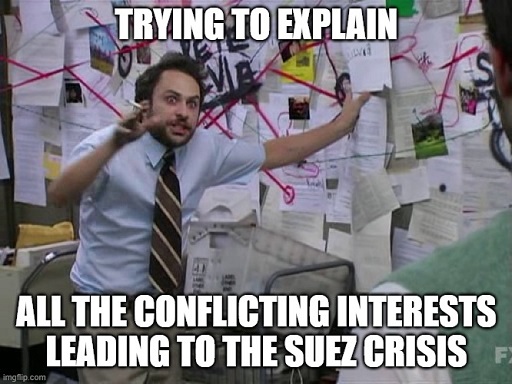
A lot of background feuds and tensions are involved in our story:
For once, Arab nationalists resent Britain and France.
We said that Nasser wants Egypt to lead the Arab world, but he is not the only one with such aspirations. Many other Arab leaders want their own countries to be the center of the Arab world, causing frictions between the leaders.
Britain has close relationships with Jordan and Iraq. Nasser, fearing that Iraq will be the center of the Middle East, becomes hostile to Britain and tries to destabilize the regimes of Iraq and Jordan.
Don’t forget that the cold war is going on. Nasser aims to be neutral in the cold war, not favoring any side, but does favor a lot of weaponry. The main supplier to Egypt is the Soviet Union, which is selling massive amounts of weapons to the country. On the other hand, Nasser’s actions against British and US interests cause the US and the UK to withdraw all financial aid for the Aswan Dam project. For example, Nasser recognized the People’s Republic of China, as opposed to the US recognition and sponsoring of the Republic of China.
France becomes the major supplier of weaponry to Israel, shipping to Israel large amounts of weapons including fighter jets.
And the list of conflicting interests goes on and on and on…
The last piece of background you need to know is about the Suez Canal, which is the star of the Suez Canal Crisis.
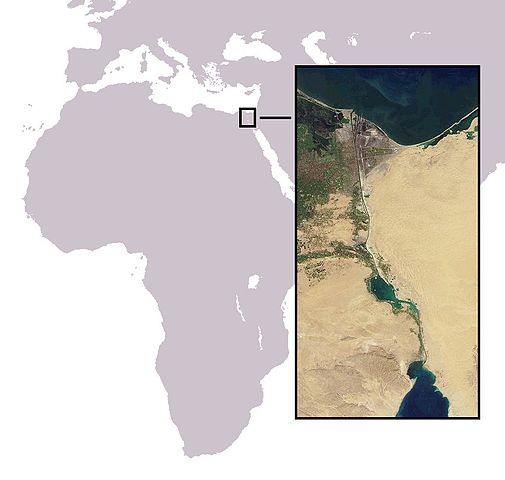
The canal goes through Egyptian territory, just East to the Sinai Peninsula. It is a crucial path of naval shipment – it connects the Mediterranean Sea to the Red Sea, saving the need to go around Africa in order for ships to get from Europe to Asia and vice versa. Some call it a lifeline between the East and West.
The United Kingdom and France own the company operating the canal (and, of course, take profit from owning it).
The Suez Crisis Emerges
This is where it all connects.
A week after the US and UK withdrew their financial aid for the Aswan Dam project, Nasser nationalizes the company operating the Suez Canal. His formal excuse is that the nationalization of the Suez Canal Company is a means to fund the Aswan Dam project in light of the British–American withdrawal.
So on 26 July, 1956, Egyptian forces seize control of the Suez Canal. Nasser announces that the Nationalization Law has been published, that all assets of the Suez Canal Company has been frozen, and that stockholders will be paid the price of their shares according to the day’s closing price on the Paris Stock Exchange.
That same day, Egypt closes both the Suez Canal and the Straits of Tiran to Israeli shipping, and blockades the Gulf of Aqaba. This is in contravention of the Constantinople Convention of 1888 as well as a violation of the 1949 Armistice Agreements.
Instant replay time – remember all the tensions and goals? So, in a single action Nasser:
- Threatens British economic and military interests in the region.
- Threatens French economic interests and outrages France to the point that the French Cabinet decides upon military action against Egypt.
- Cuts off an essential supply route to Israel, denying Israel from getting supplies, oil, food etc.
- Gains huge respect both within Egypt and from the Arab world, and his popularity goes through the roof.
Nasser ticked a lot of boxes and ticked off a lot of people that day.
So what happens next?
Well, the UK, France and Israel all have good reasons to start a war.
UK needs the canal in order to reach all the parts of its empire.
Both the UK and France have vast financial interests in owning Suez Canal Company that Nasser just took from them.
Israel is threatened by Egypt in multiple ways:
For starters, it is under naval blockade placed by the Egyptians.
Next, Egypt’s arms deal with the Soviet Union greatly increases the military power of Egypt, as it gets advanced weapons (including hundreds of tanks, dozens of fighter jets, dozens of heavy bombers, hundreds of cannons and much more).
All this is happening on top of the fact that starting 1951, dozens of terror attacks aimed at Israelis are carried out from Egypt (including Egypt controlled Gaza strip), causing over 1300 casualties on the Israeli side. This caused Israel to carry out Reprisal Operations of its own, in order to deter the terrorists and Egypt.
And last but not least, Egypt, Jordan and Syria set up a Unified Arab Military Command, threatening Israel from three fronts (South, East and North-East).
Introducing International Intrigues
The UK and France want to start a war, but they don’t want to be perceived as the aggressors. They need a reason to start a war.
Oh, what should they do, what should they do?
Well, remember that France is the major supplier of weapons to Israel? This means that France has leverage over Israel. And it decides to use this leverage.
France asks Israel to start a conflict with Egypt, giving the UK and France an excuse to intervene in the conflict, and occupy the canal area on the way.
The Prime Minister of Israel, David Ben Gurion, does not want to do so. First, he is not confident that the Israeli Defense Force can handle the mighty Egyptian army, with all its new Soviet weapons. Second, he does not want to hurt Israel’s international status, especially within the United Nations.
Yet he knows that Israel is completely dependent on France, and that without French weapons Israel will not survive in the Middle East. Thus, he unwillingly agrees.
The Elaborate Plan
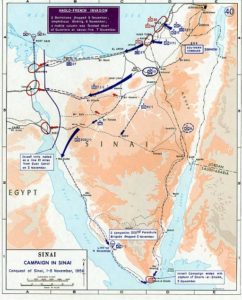
Between 22-24 of October, 1956, a triple committee is held near Paris, where the UK, France and Israel decide on the action plan.
The UK and France demand that Israel will start a full scale war against Egypt, and promise to join after 24 hours. David Ben Gurion, the Israeli Prime Minister, rejects this demand. He fears that the UK and France will not hold their side of the deal, and leave Israel to handle Egypt by itself, as well as abandon Israel in the international diplomatic front.
A compromise is agreed upon. Israel will commence a limited operation, that can be considered a reprisal operation. After the operation begins, the UK and France will present an ultimatum to both sides. Since Egypt will likely refuse to adhere, the UK and France will have the excuse they need to intervene in a military way.
Ben Gurion also demands that the UK and France will destroy the Egyptian air force while still on the ground, so that it will not be able to attack Israeli cities (and that they back their promise to do so in writing).
After a lot of negotiations, deliberations, promises and written copies of said promises, an action plan is agreed upon:
- October 28th: French squadrons will be placed in Israel, defend Israeli cities and intercept Egyptians planes.
- October 29th: Israeli paratroopers will land near the canal. This will be described as “provocation” by the UK and France, and they will present an ultimatum to both sides – all military forces should move 20 km (about 13 miles) from both sides of the canal, to protect the safety of international shipping going through the canal.
Israel will accept the ultimatum. - October 30th: If Egypt refuses to withdraw forces from the canal, the UK and France will attack the Egyptian air force until it is destroyed. Then, move on to capture the canal.
- The UK and France commit that no matter the diplomatic consequences of the war, Israeli ships will be able to move freely through the Straits of Tiran. They also commit that the Gaza strip will not be able to act as a base for terror attacks carried out in Israel by Palestinians and Egyptians.
- A by product of the committee is an agreement to sell a nuclear reactor to Israel by France.
The Suez Crisis War Begins
As planned, on October 29, 1956 Israeli paratroopers land in Sinai, about 70 km (45 miles) east of the canal, and start to head west. IDF spokesperson releases a message making this look like a reprisal operation.
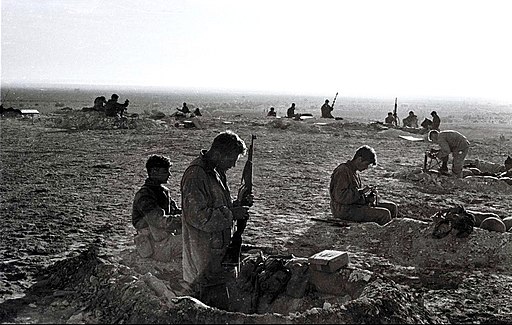
On October 30th, the UK and France present the ultimatum. They keep their end of the deal and enter the fight on October 31st.
In about a week’s time, the fear in Israel is replaced with euphoria. Against all predictions, Israeli Defense Force successfully occupies almost all of the Sinai peninsula!
When the war ends, on November 7th, Israeli forces reach 16 km (about 10 miles) east of the canal.
The UK and France, however, do not complete their objectives. Due to heavy international pressure led by the US and USSR, they have to stop the fighting before they regain control of the canal.
The Cease Fire
Due to the immense international pressure and a series of UN resolutions, the UK, France and Israel stop their fighting on November 7th.
The Anglo-French Task Force has to finish withdrawing by 22 December 1956, and be replaced by Danish and Colombian units of the UN Emergency Force.
The Israelis refuse to withdraw without guarantees about its freedom to sail through the Straits of Tiran. They also refuse to host any UN force on Israeli controlled territory until they (Israel) leave Sinai, in March 1957.
And when the Israelis do finally leave, they do it with style. Before the withdrawal the Israeli forces systematically destroy infrastructure in Sinai peninsula, such as roads, railroads and telephone lines, so that the Egyptians will not be able to launch any surprise attacks.
The Israelis also take a lot of Egyptian equipment, including six locomotives, tanks, army trucks, arms, ammunition and heavy equipment.
Aftermath and Summary of the Suez Crisis
Casualties:
British casualties stand at 16 dead and 96 wounded.
French casualties are 10 dead and 33 wounded.
The Israeli losses are 172 dead and 817 wounded.
As for the Egyptians, they suffer great losses – 1500-3000 soldiers die, 4900 wounded, 6000 others are captured. They also lose 125 tanks and over 200 airplanes. All in 9 days!
So who won the Suez Crisis? Who lost? What is the aftermath of the war?
Israel – huge win!
The Israel Defense Force gains confidence from the campaign and proves to be superior to the Egyptians forces in combat. The war demonstrated that Israel is capable of executing large scale military maneuvers in addition to small night-time raids and counter insurgency operations.
The Straits of Tiran, closed by Egypt since 1950, is reopened. Israeli shipping can now move freely through the Straits of Tiran to and from Africa and Asia. (However Israeli shipping still cannot go through the canal)
Israel also secures the presence of UN Peacekeepers in Sinai, that should prevent Egyptian surprise attacks, and gets about 10 years of relative quiet along the southern border with Egypt.
Israel’s stubborn refusal to withdraw without guarantees, even in defiance of the United States and United Nations, ends all Western efforts to impose a political settlement in the Middle East without taking Israel’s security needs into consideration.
And the cherry on top, France is supposed to secretly transmit parts of its own atomic technology to Israel, including a detonator. No one admits it ever happened to this very day…
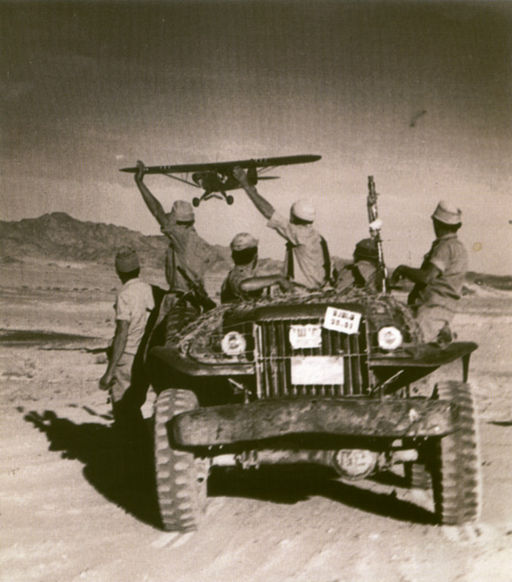
Egypt – wins as well!
This sounds weird considering the Sinai peninsula is occupied and over ten thousand soldiers are either dead, wounded or captured.
However, although the Egyptians lose in combat, they are politically strengthened. The UK and French troops withdraw soon after the war ends, and Israeli troops withdraw several months later, so they get all their land back.
Egypt officially gets to keep control over the Suez Canal, so that’s also a diplomatic win.
As for Nasser, he emerges as the grand hero in the Arab world – many Arabs see Nasser as the conqueror of European colonialism and Zionism, simply because Britain, France and Israel have to leave the Sinai and the northern Canal Zone. The fact that they have to leave due to international pressure and not due to defeat in combat does not change the perceived Egyptian victory.
The Jewish community in Egypt loses greatly. Egypt begins to persecute the Jews living in the country, branding the Jews as “Zionists and enemies of the state”. Over 1000 Jews are arrested, Jewish bank accounts are confiscated and many Jews lose their jobs, Jewish businesses are seized. Thousands of Jews are ordered to leave the country, allowed to take only one suitcase and a small sum of cash, and forced to sign declarations “donating” their property to the Egyptian government. Some 25,000 Jews, almost half of the Jewish community, leave mainly for Israel, Europe, the United States and South America. And by 1957 the Jewish population of Egypt falls to 15,000.
The UK and France lose the Suez Crisis. Big time.
Both the UK and France sustain heavy damages in the international diplomatic front.
The UN gave control over the Suez Canal to Egypt, so Britain and France failed to achieve their main objective.
In Britain the British Prime Minister, Anthony Eden, is accused of misleading parliament and resigns from office on 9 January 1957.
The Suez Crisis is also a blow to British prestige in the Near East from which the country never recovers.
In France, Franco-American ties never recovered from the Suez Crisis. Guy Mollet’s position as French Prime Minister is heavily damaged, and he resigns from office in May 1957.
Summary
This concludes the Suez Crisis of 1956, also known as the Suez Canal Crisis, the Sinai War and “Operation Kadesh”.
Egypt is depicted as the grand winner in the eyes of the Arab world. Israel is recognized as a force to be reckoned with. The UK and France lose their prestige and have to shamefully withdraw without achieving any of their goals.
And, as a result, the next war is already put in motion. You may know it as The Six Day War of 1967.

